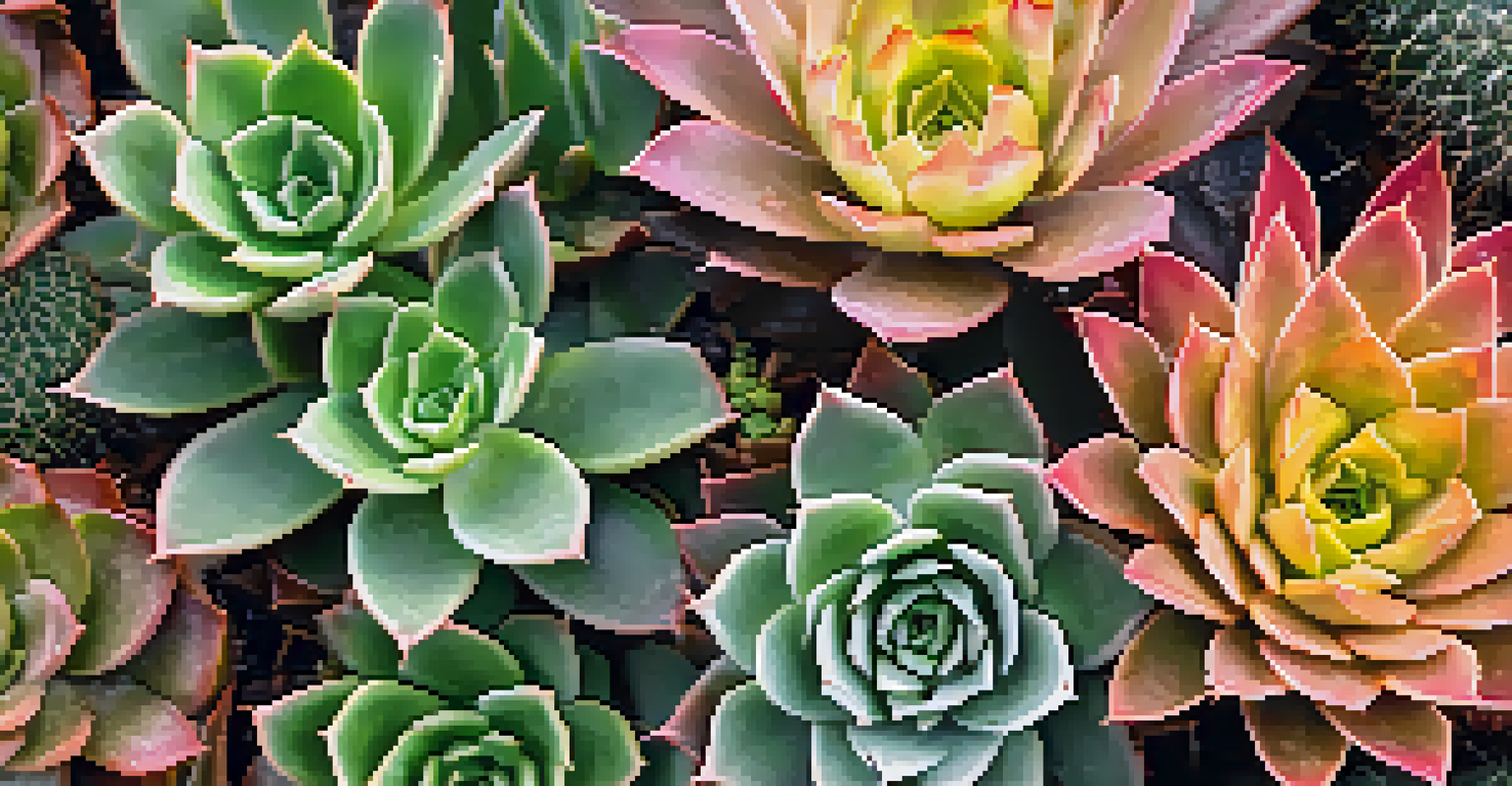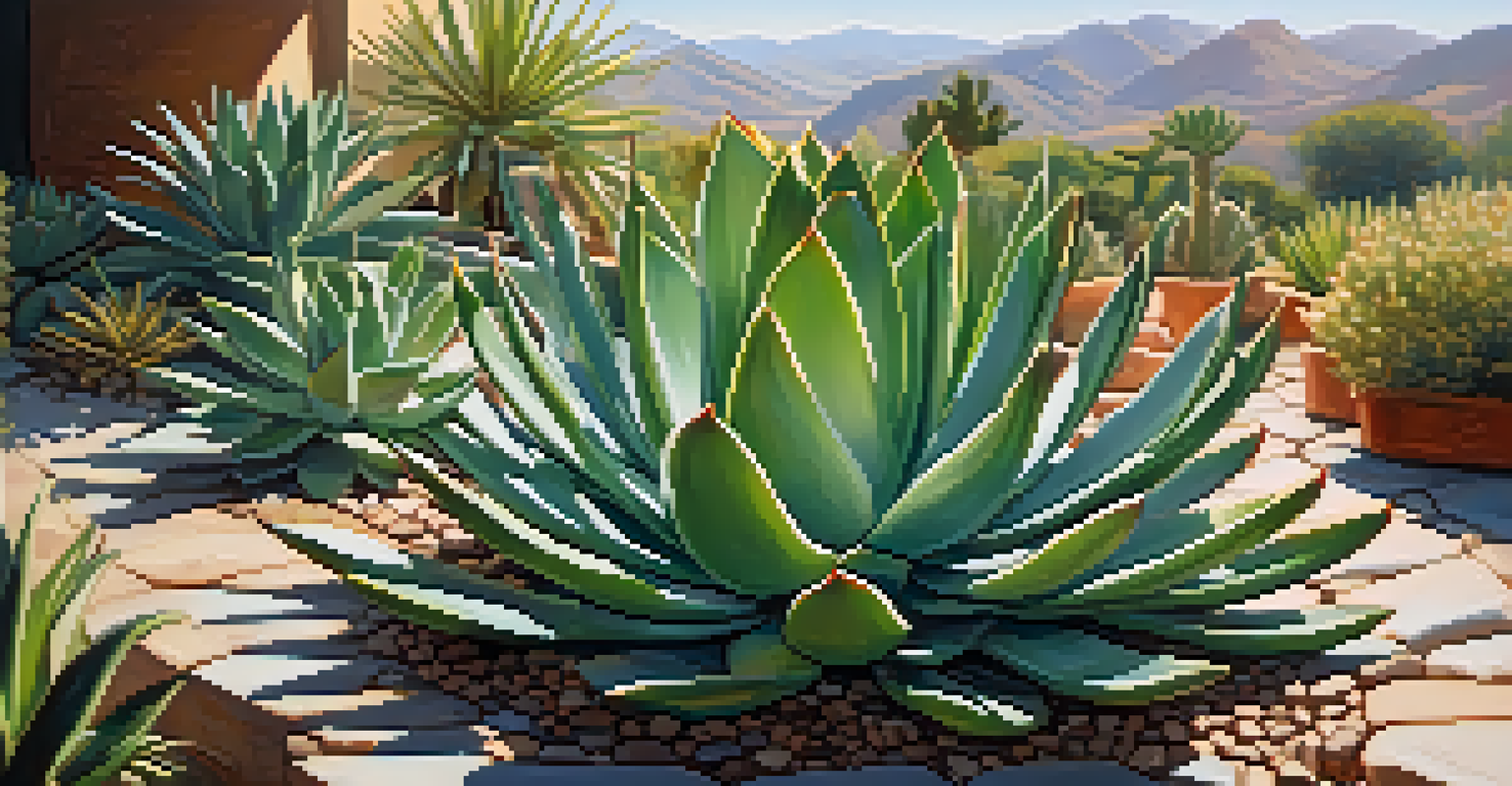How to Create a Stunning Cacti and Succulent Garden Landscape

Understanding Cacti and Succulents: The Basics
Cacti and succulents are not just trendy; they're resilient and low-maintenance plants. While both belong to the same family, cacti usually have spines, while succulents store water in their leaves. This unique adaptation allows them to thrive in arid environments, making them perfect for gardens with plenty of sun and minimal water.
Succulents are like little reservoirs, storing water in their leaves to survive in harsh conditions.
Before diving into planting, it's essential to understand their growth habits and needs. Most cacti and succulents prefer well-draining soil and bright, indirect sunlight. Knowing these basics will help you create a thriving garden that showcases their beauty and unique characteristics.
In addition to being hardy, these plants come in various shapes, sizes, and colors, providing endless design possibilities. From the tall and majestic saguaro to the tiny, colorful echeveria, there's a succulent or cactus for every garden style. Embracing this diversity is key to creating a visually stunning landscape.
Choosing the Right Location for Your Garden
The first step in creating your cacti and succulent garden is selecting the right location. Ideally, you want a spot that receives at least six hours of sunlight daily, as these plants thrive in bright conditions. A south-facing area in your yard could be the perfect choice, ensuring they soak up all that much-needed light.

Consider the drainage in your chosen location. Cacti and succulents are prone to root rot if left in standing water, so look for an area that drains well after heavy rains. You can also elevate your garden bed or use pots with drainage holes to help manage excess moisture.
Choose the Right Location
Select a sunny spot with good drainage to ensure your cacti and succulents thrive.
Finally, take into account the aesthetic appeal of the location. Placing your garden near a patio or pathway allows you to enjoy the beauty of your cacti and succulents up close. Plus, it creates a welcoming environment for guests to admire your green thumb.
Selecting the Right Plants for Your Landscape
With so many varieties of cacti and succulents available, it can be overwhelming to decide which ones to include in your garden. A good strategy is to choose a mix of different shapes, sizes, and colors to create visual interest. For instance, pairing tall columnar cacti with low, sprawling succulents can provide depth and texture to your landscape.
Gardening adds years to your life and life to your years.
It's also a great idea to consider the climate in your area. Some cacti and succulents are more suited to cooler temperatures while others thrive in heat. Researching native species can help you select plants that will flourish in your specific environment, ensuring a low-maintenance garden.
Additionally, think about plant compatibility. Some succulents might compete for nutrients, while others can thrive together. Grouping plants with similar water and light requirements will make it easier to care for your garden and ensure that each plant gets what it needs.
Designing Layout: Arranging Your Plants Creatively
Designing a layout for your cacti and succulent garden is where the fun begins! Start by sketching out a plan that highlights the unique characteristics of each plant. Consider using varying heights—taller cacti in the back and shorter succulents in the front—to create a layered effect that draws the eye.
You might also want to create focal points with standout plants or clusters. For instance, a vibrant centerpiece like a large agave can anchor the garden, surrounded by smaller succulents that complement its color. Using contrasting colors and textures will help each plant shine while maintaining harmony.
Mix Plant Varieties for Interest
Incorporate different shapes, sizes, and colors of cacti and succulents for a visually appealing garden.
Don’t forget about pathways or borders! Adding pebbles, sand, or decorative stones can enhance the aesthetic and provide a distinct separation between different sections. This thoughtful arrangement can make your garden not only visually appealing but also inviting to explore.
Preparing the Soil for Planting: Tips and Tricks
Preparing the soil is a crucial step to ensure your cacti and succulents thrive. Start with a well-draining soil mix, which you can easily create by combining potting soil with sand or perlite. This mix helps prevent water from pooling around the roots, reducing the risk of rot.
Before planting, it's wise to amend the soil with organic matter, like compost, to enrich it without making it too dense. This addition will provide vital nutrients while maintaining the necessary drainage. Just be careful not to overdo it—cacti and succulents prefer lean soil.
Once your soil is ready, consider adding a layer of gravel or small stones on top after planting. This not only helps with drainage but also adds an appealing finish to your garden, while minimizing weed growth. A little attention to soil preparation goes a long way in promoting healthy, vibrant plants.
Watering Your Cacti and Succulents: Finding the Balance
One of the most common mistakes with cacti and succulents is overwatering. These plants are designed to store water, so it's crucial to let the soil dry out completely between watering sessions. A simple rule of thumb is to water them once every 2-3 weeks, depending on the climate and season.
To check if your plants need water, insert your finger into the soil about an inch deep. If it feels dry, it's time to water. When you do, soak the soil thoroughly, allowing excess water to drain out. This encourages deep root growth and helps the plants become more resilient.
Water Wisely for Healthy Growth
Allow soil to dry out completely between waterings, adjusting frequency with the seasons to prevent overwatering.
During the dormant winter months, reduce your watering frequency even further. Cacti and succulents naturally slow down their growth during this time, and overwatering can lead to serious issues. Adjusting your watering habits seasonally is key to maintaining a healthy garden.
Maintaining Your Cacti and Succulent Garden Year-Round
Maintenance is essential for keeping your cacti and succulent garden looking its best. Regularly check for pests—like mealybugs or aphids—that can harm your plants. If you spot any, gently remove them with a cotton swab dipped in rubbing alcohol to keep your garden healthy and thriving.
Another important aspect of maintenance is pruning. Dead or damaged leaves should be removed promptly to encourage new growth and prevent disease. Additionally, repotting may be necessary every few years to refresh the soil and allow for continued growth.

Lastly, don’t forget to enjoy your garden! Spend some time each week admiring your plants and making adjustments to their arrangement as they grow. A little love and attention will go a long way in ensuring your cacti and succulent garden remains a stunning focal point in your landscape.